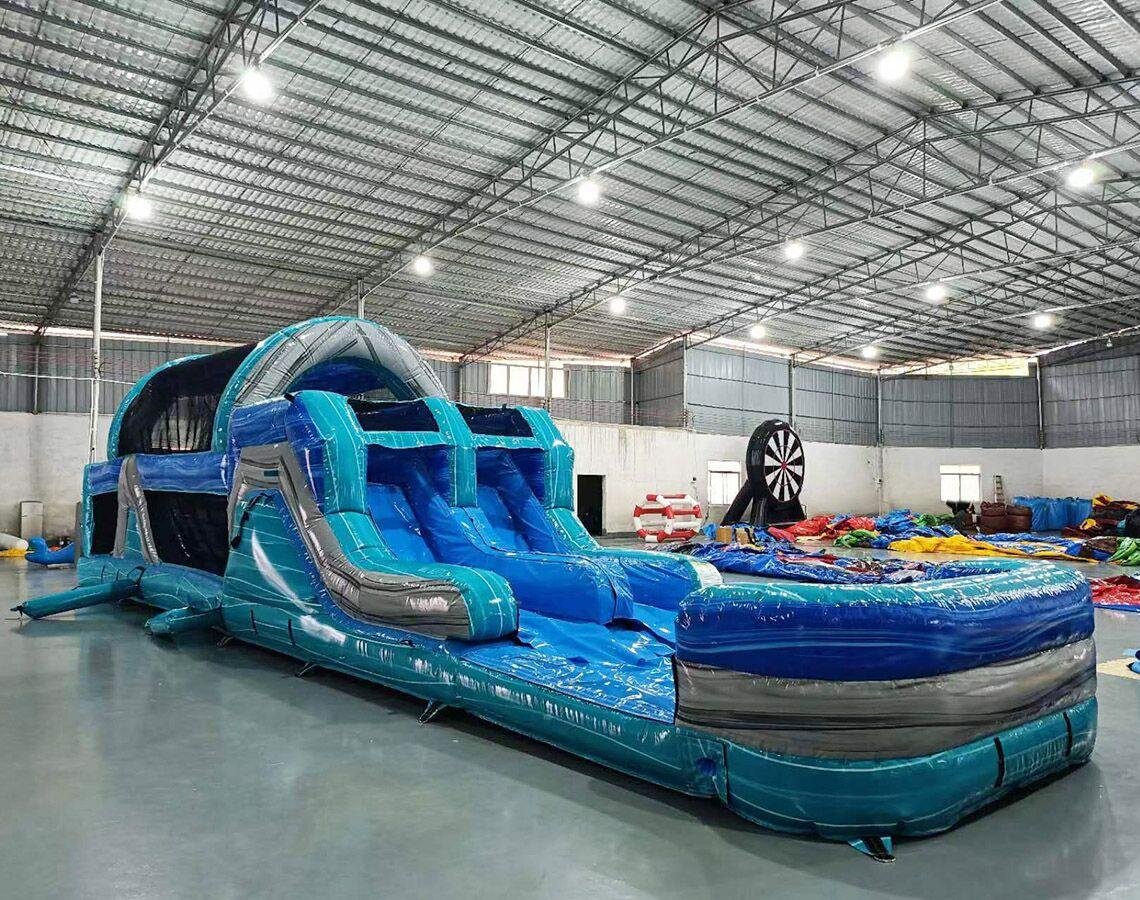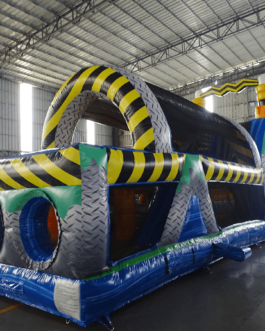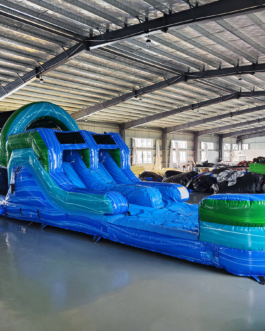Conquering the Crimson Bay Hybrid Obstacle Course: A Guide to Success
Original price was: $3,595.00.$2,595.00Current price is: $2,595.00.
46′ Crimson Bay Hybrid obstacle bounce house for sale and stand out from the competition! Suitable for both wet and dry rental usage, this obstacle guarantees durability and rental success.
Description
Introduction to the Crimson Bay Hybrid Obstacle Course
The Crimson Bay Hybrid Obstacle Course is an innovative athletic experience that seamlessly merges traditional obstacle racing with elements of adventure sports. This course is designed to challenge participants both mentally and physically, presenting a series of unique obstacles set against the stunning backdrop of Crimson Bay. Located in a scenic coastal area, the course capitalizes on the natural terrain, incorporating water, elevation changes, and rugged landscapes to create an engaging and dynamic environment for competitors.
The concept of hybrid obstacle courses has gained traction in recent years, driven by a growing interest in multifaceted athletic challenges. By combining components from various disciplines, such as trail running, climbing, and aquatic activities, the Crimson Bay course offers a distinctive experience that appeals to a wide range of athletes. Participants can expect a high level of intensity, as the course is designed to test endurance, strength, and flexibility, making it suitable for both seasoned athletes and enthusiastic newcomers seeking a thrilling experience.
The target audience for the Crimson Bay Hybrid Obstacle Course includes fitness enthusiasts, adventure seekers, and anyone looking to push their physical limits. The challenges that participants will encounter include climbing walls, rope courses, uneven terrains, and water crossings, all crafted to stimulate various muscle groups and enhance overall fitness. Furthermore, this course fosters a sense of community, inviting participants to not only compete against themselves but also to support and motivate fellow athletes along the way.
As individuals prepare for the Crimson Bay Hybrid Obstacle Course, they are encouraged to train for the unique demands of the course while cultivating resilience and teamwork. This event serves as an exciting addition to the athletic community, promoting personal growth and adventure through its unparalleled challenges.
Training for the Hybrid Challenge
Preparing for the Crimson Bay Hybrid Obstacle Course requires a multifaceted training regimen that focuses on enhancing strength, endurance, agility, and flexibility. The nature of this hybrid challenge necessitates not only physical resilience but also mental stamina. As participants embark on their training journey, they should incorporate a variety of exercises tailored to develop the required skills.
Strength training is vital for overcoming obstacles effectively. Incorporating compound movements such as squats, deadlifts, and bench presses will build the foundational strength necessary to navigate the course. Resistance training should focus on functional movements that mimic the various challenges participants will face. Additionally, performing bodyweight exercises like pull-ups and push-ups can greatly enhance upper body strength, crucial for climbing and crawling sections of the course.
Endurance is also essential. Engaging in cardiovascular activities such as running, cycling, or swimming will develop the aerobic capacity needed to sustain energy throughout the race. Interval training, which combines bursts of high-intensity activity with periods of rest, is particularly effective in mimicking the varied demands of an obstacle course. This includes running sprints followed by active recovery walks, helping to improve both speed and stamina.
Agility and flexibility should not be overlooked, as they play a crucial role in maneuvering through obstacles. Exercises such as lateral hops, ladder drills, and dynamic stretching will enhance coordination and mobility. Participants should ensure to dedicate time for flexibility training, incorporating yoga or targeted stretching routines into their weekly schedule.
In terms of nutrition and hydration, fueling the body appropriately is imperative. A balanced diet rich in protein, healthy fats, and complex carbohydrates will provide the necessary energy for training. Staying hydrated before, during, and after workouts is equally important, as proper hydration supports optimal physical performance.
Mental preparation is another crucial aspect of training. Participants should practice visualization techniques, mentally rehearsing the course and their strategies. Setting realistic goals and maintaining a positive mindset will not only build confidence but also ensure they approach the race with a clear focus. With this comprehensive training regimen, participants can maximize their performance during the Crimson Bay Hybrid Obstacle Course, setting themselves up for a successful challenge.
What to Expect on Race Day
Race day at the Crimson Bay Hybrid Obstacle Course promises to be an exhilarating experience filled with anticipation and challenge. Participants should aim to arrive early to secure a smooth registration and familiarize themselves with the environment. Upon arrival, participants will check in at the designated registration area, where they will receive their race bibs and any necessary materials. This is also the time to address any last-minute questions and ensure that your gear is ready for the day ahead.
As the race start time approaches, it is essential to engage in a proper warm-up routine. This may involve light jogging, dynamic stretches, and mobility exercises, which help to prepare the body for the physical demands ahead. Group warm-up sessions may also be organized, allowing participants to connect and tap into the communal energy that fills the air with excitement and camaraderie.
The course layout is both challenging and engaging, comprising a variety of obstacles that test both physical prowess and mental tenacity. Participants can expect to encounter walls, mud pits, rope climbs, and jungle gyms strategically placed throughout the course. Each challenge is designed to push competitors to their limits, yet offers a thrilling sense of accomplishment upon completion. The landscape may include a mix of wooded areas, open fields, and water features, providing both beauty and complexity. It is crucial for participants to familiarize themselves with the layout and know what to anticipate.
The atmosphere on race day is invigorating, characterized by the bonds formed among competitors as they cheer each other on through obstacles. Spectators also play a pivotal role, their encouragement amplifying the energy of the event. They create a supportive environment acts as a motivating force, reminding participants that they are not alone in this adventure. Embracing the blend of competition and community is essential as you prepare to conquer the Crimson Bay Hybrid Obstacle Course.
Tips and Strategies for Success
Navigating the Crimson Bay Hybrid Obstacle Course requires a blend of physical prowess, mental resilience, and strategic planning. To enhance your performance, it is imperative to approach each obstacle with specific techniques tailored to maximize efficiency. For instance, when faced with climbing walls, focus on using your legs primarily; they offer more strength than your arms. Ensure you maintain a firm grip with your hands, while simultaneously using your legs to push off for upward momentum. Prioritizing leg strength can significantly reduce fatigue during the ascent.
Concerning mud pits, it is vital to maintain a steady pace. Sinking into mud can lead to injury or significant slowdown. A quick, agile approach, where you minimize your contact time with the mud, can be beneficial. Selecting strategic footholds and swiftly navigating through the pit will mitigate the time spent in the muck and keep your energy levels up.
Rope courses demand not only upper-body strength but also a sound mental strategy. Focus on your grip and body positioning to enable smooth transitions between obstacles. Visualize your path before attempting any movements, as this mental preparation can drastically improve your success rate. In addition, practicing with a team can foster effective communication and enhance teamwork strategies. These collaborations can be invaluable during obstacles that require assistance, such as helping each other through tricky climbs or supporting one another during challenging sections.
Dealing with setbacks is also an essential component of succeeding in the Crimson Bay Hybrid Obstacle Course. Recognizing that all participants face challenges enables one to develop a resilient mindset. Monitor your pacing, and if you encounter an obstacle that proves too daunting, take a moment to regroup and reassess your approach. Emphasizing mental resilience and flexibility can lead to improved performance and an enjoyable experience.
Post-Race Recovery and Reflection
Completing the Crimson Bay Hybrid Obstacle Course is a significant achievement, and it is essential to prioritize post-race recovery to ensure optimal recuperation and readiness for future challenges. Athletes should first focus on immediate care after crossing the finish line. This includes cool down exercises, such as light jogging or walking, which help gradually lower the heart rate after intense exertion. Stretching is also crucial during this time. Engaging in dynamic and static stretches can alleviate muscle tension, enhance flexibility, and prevent stiffness.
Rehydration plays a vital role in recovery. The body loses a considerable amount of fluids during such a strenuous race, which must be replenished expeditiously. Athletes are encouraged to drink water or electrolyte-rich beverages to restore balance and support bodily functions. Nutrition post-race should also be prioritized. Consuming a mix of carbohydrates and proteins helps repair muscle damage and replenish glycogen stores, which are essential for recovery. Foods high in vitamins and minerals will further boost recovery by supporting the immune system, which may be compromised after intense physical activities.
Long-term recovery strategies should also be part of an athlete’s regimen. Incorporating rest days into training schedules, engaging in cross-training activities, and practicing active recovery techniques—such as yoga or swimming—can prevent injuries and enhance overall fitness. It is equally important to reflect on the race experience. Athletes should take time to celebrate their accomplishments, assessing their performance against set goals. Furthermore, identifying areas for improvement can foster growth and prepare them for future events. Whether it be refining technique or adjusting training routines, continuous reflection will help build resilience and enhance future performance.






Reviews
There are no reviews yet.